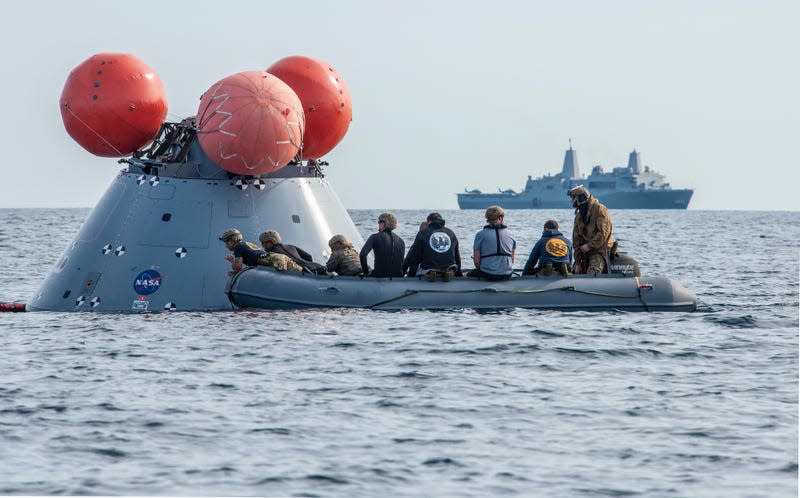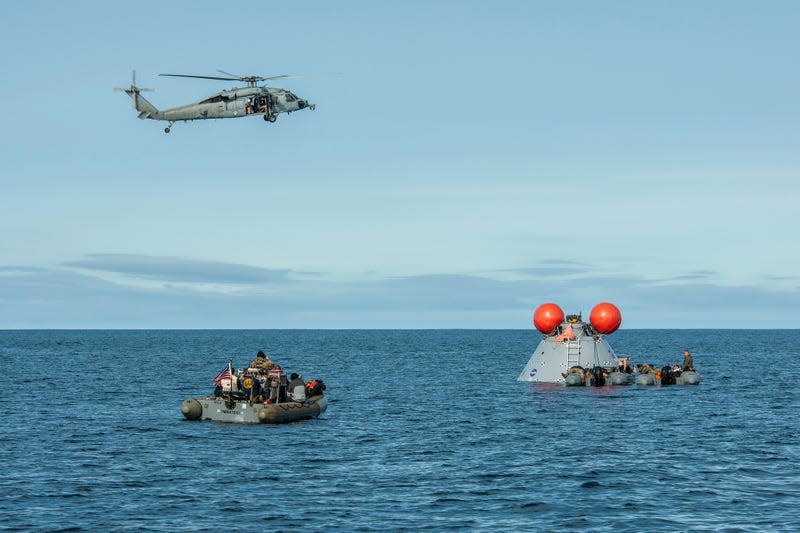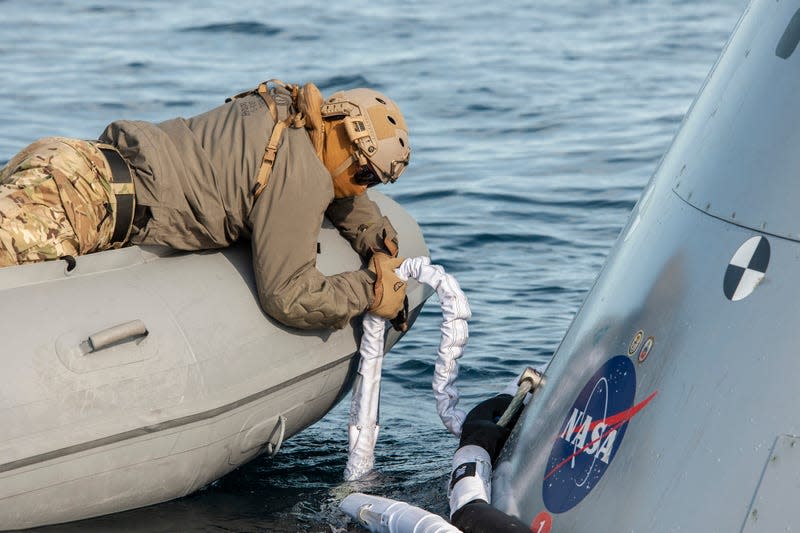Here’s What Will Happen Once NASA’s Orion Splashes Down on Sunday

Should all go as planned, NASA’s Orion spacecraft will splash down off the coast of Baja, California, on Sunday, December 11 at 12:40 p.m. ET. As the uncrewed capsule bobs up and down in the open ocean, a crack team will spring into action and attempt to pull off a carefully choreographed recovery operation. Here’s how we expect it to unfold.
The sight of Orion floating in the Pacific Ocean will most assuredly be a welcome sight this Sunday, but it will also be a time for reflection. The spacecraft will have completed a remarkable journey, in which it buzzed the lunar surface at a distance of 81 miles (130 kilometers) and ventured nearly 43,000 miles (69,000 km) beyond the Moon. At its maximum distance, Orion was 268,554 miles (432,194 km) from Earth, setting a new record for a passenger-rated spacecraft.
Read more
Just as remarkably, Orion will have survived a harrowing reentry through the Earth’s atmosphere, having endured 5,000 degree Fahrenheit temperatures upon hitting the atmosphere at 20,000 miles per hour (32,2000 km/hr). We’ll have Orion’s innovative heat shield and NASA’s skip re-entry procedure to thank, should the spacecraft’s return to Earth go well. NASA’s SLS rocket launched Orion to space on November 16, sending it on a 25.5-day mission to the Moon and back.
The immediate moments after splashdown will bring relief and introspection, but for NASA’s Landing Recovery Team, it’ll be showtime. It’s a big responsibility to recover Orion, not only because NASA will want to study every nook and cranny of its returning spacecraft but also because future Artemis missions will involve a living, breathing crew. The sequel mission in two years, Artemis 2, will include four astronauts, who will undoubtedly want to get out of the capsule as quickly as possible following splashdown.

The Landing Recovery Team, headed by Kennedy Space Center’s Exploration Ground Systems, will have help from the U.S. Department of Defense, including the Navy and Air Force. Also taking part will be technicians and engineers from Kennedy, Johnson Space Center, and Lockheed Martin, according to a NASA fact sheet.
Orion is expected to splash down about 100 miles (160 kilometers) west of Guadalupe Island. The original landing site, a spot 60 miles (100 km) to the west of San Diego, could not be used on account of expected bad weather, as Mike Sarafin, Artemis mission manager, told reporters yesterday. The newly chosen target area is 345 miles (556 km) up range from the original site and off the coast of Baja, California. Speaking at the same press briefing, Judd Frieling, Artemis flight director, said the new landing area is “well within our test objectives.”
The recovery team will spring into action approximately three hours prior to splashdown and collect as much data about the conditions as possible, Melissa Jones, Artemis 1 recovery director, told reporters at a briefing back in August. Weather balloons will have been deployed 24 hours prior to Orion’s arrival. The USS John P. Murtha, a San Antonio-class amphibious transport dock ship, will take the team to the designated landing area. This class of ship features a well deck at the waterline, allowing watercraft—or in this case spacecraft—to dock inside the vessel.

Following splashdown, a helicopter crew will inspect the capsule to make sure it’s safe to recover. Once Jones gives the official “go ahead” to proceed, Navy divers and other team members will approach the capsule in inflatable boats. Divers will swim underneath the capsule to assess the vehicle’s condition and take photos.
Among the first tasks will be for the divers to attach a stabilization collar, or “pony collar,” around Orion’s base. They’ll also install an inflatable platform that will serve as a kind of front porch for future astronauts to use as they exit the vehicle. As this is happening, other team members will attempt to recover Orion’s jettisoned forward bay cover, drogue chutes, and three main parachutes. The team will also take Orion’s temperature to determine the rate at which it’s cooling down, according to Jones.
Under normal circumstances, astronauts will exit only after the capsule is safely inside the Navy’s ship, but the recovery team does have the option to extricate crew members while Orion floats in the open water (in the event of a medical emergency, for example). That said, they’d only be able to do that if sea and weather conditions permit.
The team will then prep Orion for its trip to the awaiting dock ship. Divers will attach a winch line and a series of tending lines to the capsule. The team will use these lines to pull Orion toward the ship and tenderly position it within a specialized assembly known as the “cradle.” The final steps will involve the draining of the well deck and the retrieval of the bay cover and parachutes.

The process, from splashdown to placement in the cradle, will take between four and five hours, according to Jones. In the event of an emergency, however, the recovery team figures it can get an astronaut to the ship’s medical bay in around 80 to 90 minutes, she added. “Artemis 1 will refine these estimates,” Jones said, and “we believe we can refine these procedures and do it quicker.” The team has practiced all of this before, but now it’s the real deal, though without any astronauts on board (that said, three manikins took part in the Artemis 1 mission, gathering data on g-forces and radiation exposure).
The USS John P. Murtha will transport Orion to a pier at a San Diego naval base, where it will be positioned into a truck and transported back to Kennedy Space Center in Florida. The parachutes and bay cover, should they be recovered, will be sent off for drying and inspection.
And that’ll be a wrap for Artemis 1, the first in a series of increasingly complex missions to the lunar environment. Fingers crossed, the recovery will go exactly as planned and we’ll get to do it all over again in 2024—but with an actual crew on board.
More: Orion Will ‘Skip Like a Rock’ Across Earth’s Atmosphere During Upcoming Reentry
More from Gizmodo
Sign up for Gizmodo's Newsletter. For the latest news, Facebook, Twitter and Instagram.

